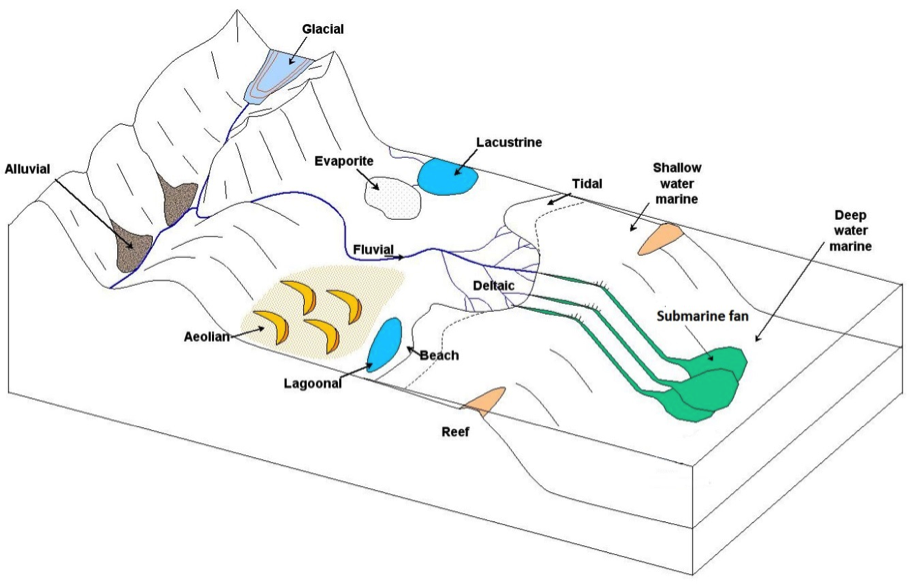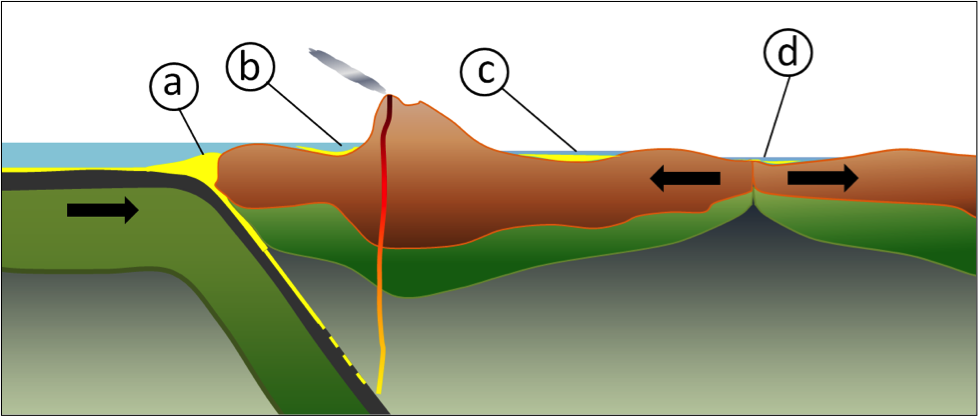5.4 Depositional Environments and Sedimentary Basins
Sediments accumulate in a wide variety of environments, both on the continents and in the oceans. Some of the more important of these environments are illustrated in Figure 5.20.

Tables 5.1 and 5.2 provide a summary of the processes and sediment types that pertain to the various depositional environments illustrated in Figure 5.19. The types of sediments that accumulate in these environments are examined in more detail in the last section of this chapter.
| Table 5.1 Terrestrial Depositional Environments | |||
| Environment | Key Transport Processes | Depositional Settings | Typical Sediments |
|---|---|---|---|
| Glacial | Gravity, moving ice, moving water | Valleys, plains, streams, lakes | Glacial till, gravel, sand, silt, clay |
| Alluvial | Gravity, moving water | Where steep-sided valleys meet plains | Coarse angular fragments |
| Fluvial | Moving water | Streams | Gravel, sand, silt, organic matter |
| Aeolian | Wind | Deserts and coastal regions | Sand, silt |
| Lacustrine | Moving Water | Lakes | Sand, silt, clay, organic matter |
| Evaporite | Still water | Lakes in arid regions | Salts, clay |
| Source: Karla Panchuk (2018) CC BY 4.0, modified after Steven Earle (2015) CC BY 4.0 view source. | |||
| Table 5.2 Marine Depositional Environments | |||
| Environment | Key Transport Processes | Depositional Settings | Typical Sediments |
|---|---|---|---|
| Deltaic | Moving water | Deltas | Sand, silt, clay, organic matter |
| Beach | Waves, long-shore currents | Beaches, spits, sand bars | Gravel, sand |
| Tidal | Tidal currents | Tidal flats | Fine-grained sand, silt, clay |
| Reef | Waves, tidal currents | Reefs and adjacent basins | Carbonates |
| Shallow marine | Waves, tidal currents | Shelves, slopes, lagoons | Carbonates in tropical climates; sand/silt/clay elsewhere. |
| Lagoonal | Little transportation | Lagoon bottom | Carbonates in tropical climates, silt, clay |
| Submarine fan | Underwater gravity flows | Continental slopes, abyssal plains | Gravel, sand, silt, clay |
| Deep water | Ocean currents | Deep-ocean abyssal plains | Clay, carbonate mud, silica mud |
| Source: Karla Panchuk (2018) CC BY 4.0, modified after Steven Earle (2015) CC BY 4.0 view source. | |||
Most of the sediments that you might see around you, including talus on steep slopes, sand bars in streams, or gravel in road cuts, will never become sedimentary rocks. This is because they have only been deposited relatively recently — perhaps a few centuries or millennia ago — and will be re-eroded before they are buried deep enough beneath other sediments to be lithified. In order for sediments to be preserved long enough to be turned into rock (a process that takes millions or tens of millions of years) they need to have been deposited in a basin in which sediments can be preserved for that long. Most such basins are formed by plate tectonic processes (Figure 5.21).

Trench basins form where a subducting oceanic plate dips beneath the overriding continental or oceanic lithosphere. They can be several kilometers deep, and in many cases, host thick sequences of sediments from nearby eroding coastal mountains. There is a well-developed trench basin off the west coast of Vancouver Island.
A forearc basin lies between the subduction zone and the volcanic arc, and may be formed in part by friction between the subducting plate and the overriding plate, which pulls part of the overriding plate down. The Strait of Georgia, the channel between Vancouver Island and the BC mainland, is a forearc basin.
A foreland basin is caused by the mass of a mountain range depressing the crust. A rift basin forms where continental crust is being pulled apart, and the crust on both sides the rift subsides. If rifting continues this will eventually becomes a narrow sea, and then an ocean basin. The East African rift basin represents an early stage in this process.
Licenses and Attributions
“Physical Geology, First University of Saskatchewan Edition” by Karla Panchuk is licensed under CC BY-NC-SA 4.0 Adaptation: Renumbering

